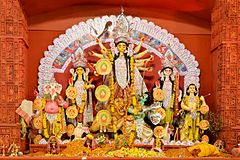| Ayudha Puja | |
|---|---|
 Murti of the goddess Durga, venerated on Ayudha Pooja | |
| Also called | Ayudha Puja also observed as Saraswathi Puja |
| Observed by | Hindus |
| Type | Religious |
| Celebrations | Ayudha Puja and Saraswati Puja |
| Observances | Veneration of implements, machines, weapons, books, and musical instruments |
| Begins | The Navami (ninth) day of Navaratri |
| 2023 date | 23 October 2023 |
| 2024 date | 11 October 2024 |
| Frequency | Annual |
| Related to | Navaratri, Golu |

Ayudha Puja (Sanskrit: आयुध पूजा, romanized: Āyudha Pūjā, lit. 'worship of tools') is a Hindu observance that falls on the ninth day of the bright half of the moon's cycle of 15 days (as per the Hindu calendar) in the month of September/October, popularly a part of the Navaratri festival.[2] While the Navaratri festival is observed all over the country, the festivity that is widely marked as Ayudha Puja possesses slight variations of veneration and practices across India.[3][4]
The principal goddesses worshipped during the Ayudha Puja are Saraswati, the goddess of learning, Lakshmi, the goddess of prosperity, and Parvati, the goddess of power.[5] On this occasion, the implements employed by people of various professions and walks of life are customarily venerated, such as the weapons of a soldier, tools of an artisan, and the books of a student. The religious significance of this occasion is to commemorate the victory of the goddess Durga over Mahishasura, or the conquest of Lanka by Rama.[4] In South India, the occasion is primarily dedicated to Saraswati, with the practice of educational materials such as books, pens, pencils, musical instruments, and other equipment being venerated, to signify the victory of knowledge over ignorance.[6][7]
In the contemporary era, the tradition of this occasion is retained by the consecration of computers, typewriters, and mobile phones in the same manner as practiced in the past for weapons of warfare.[8][9] In Orissa, tools traditionally used for cultivation like plough, war like sword and dagger, and inscription writing like "karani" or "lekhani" (metal stylus) are worshipped.[10]
- ^ "Ayudha Puja Celebration 2017, Significance of Ayudha Festival". Archived from the original on 2017-12-04. Retrieved 2016-09-29.
- ^ Dalal, Roshen (2014-04-18). The Religions of India: A Concise Guide to Nine Major Faiths. Penguin UK. p. 230. ISBN 978-81-8475-396-7.
- ^ Kittel, F (1999). Kannada English Dictionary. Asian Educational Services. p. 162. ISBN 978-81-206-0049-2. Retrieved 2009-09-18.
{{cite book}}:|work=ignored (help) - ^ a b Ishwaran, Karigoudar (1963). International studies in sociology and social anthropology, Volume 47. Brill Archive. p. 206.
The Ayudhapuja is a festival that occurs some times in the months of September/October every year in the Karnataka State, to celebrate an episode from the Mahabharata, in which the exiled Pandavas worship their weapons. It is now celebrated by all as worship of whatever tools or material they use to eke out their livelihood
{{cite book}}:|work=ignored (help) - ^ Ziegenbalg, Bartholomaeus (1869). Genealogy of the South-Indian gods: a manual of the mythology and religion ... Higginbotham. p. 208. Retrieved 2009-09-18.
{{cite book}}:|work=ignored (help) - ^ Pechilis, Karen; Raj, Selva J. (2013). South Asian Religions: Tradition and Today. Routledge. p. 56. ISBN 978-0-415-44851-2.
- ^ Kamath, Rina (September 2000). Chennai. Orient Blackswan. p. 104. ISBN 978-81-250-1378-5.
- ^ Saraswati, T.S (2003). Cross-cultural perspectives in human development: theory, research, and ... Sage. p. 194. ISBN 978-0-7619-9769-6. Retrieved 2009-09-18.
{{cite book}}:|work=ignored (help) - ^ Dodiya, Jaydipsinh (2000). Indian English poetry: critical perspectives. Sarup & Sons. p. 103. ISBN 978-81-7625-111-2. Retrieved 2009-09-18.
- ^ Kanungo, Panchanan (2014). Sanskruti Baibhaba. Bhubaneswar.
{{cite book}}: CS1 maint: location missing publisher (link)